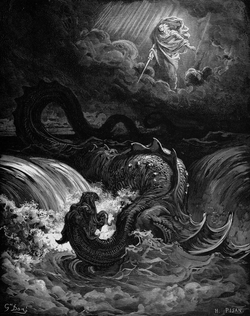
Zojz [a] is a sky and lightning god in Albanian pagan mythology. [2] Regarded as the chief god and the highest of all gods, traces of his worship survived in northern Albania until the early 20th century, and in some forms still continue today. [3] The old beliefs in the Sky (Alb. Qielli) are pagan beliefs preserved by Albanians since ancient times. [4] In Albanian the god who rules the sky is referred to as i Bukuri i Qiellit ("the Beauty of the Sky"), a phrase that is used in pagan contexts for the Sun (Dielli), worshiped as the god of light, sky and weather, giver of life, health and energy, and all-seeing eye. [5] The sacred significance of one of the main symbols of the sky cult – the eagle – has been scrupulously preserved by Albanians, who have always considered it their animal totem. [6] An epithet considered to be associated with the sky-god is "father", thought to be contained in the Albanian noun Zot ("Sky Father", from Proto-Albanian: *dźie̅u ̊ a(t)t-), used to refer to the supreme entity. [7] A remarkable reflection of Proto-Indo-European mythology associated with the dawn goddess *H₂éwsōs is the Albanian tradition according to which the dawn goddess – Prende – is the daughter of the sky god – Zojz.
Contents
- Name
- Etymology
- Epithets
- Reflections
- History
- Cult, practices and folk beliefs
- Sky and lightning
- Dualistic struggle – cosmic renewal
- Role and attributes
- Mountain cult and sacrifices
- Sky and Earth pairing
- Mythical tale
- Synopsis
- In oral epic poetry
- See also
- References
- Notes
- Citations
- Bibliography

In classical antiquity Zojz was presumably worshiped by Illyrians as the ancestors of the Albanians. [8] Albanian Zojz is the clear equivalent and cognate of Messapic Zis and Ancient Greek Zeus (all from Proto-Indo-European *Di̯ḗu̯s 'sky god'). [9] The Albanian tradition according to which the Sun is an "eye", [10] is a reflection of the Indo-European belief according to which the Sun is the eye of the Sky-God. [11] The Sun, referred to as "the all-seeing (big) eye" is invoked in Albanian solemn oaths (be), and information about everything that happens on Earth is asked to the all-seeing Sun in ritual songs. [12] [13] Albanian folk beliefs regard the lightning as the "fire of the sky" ( Zjarri i Qiellit ) and consider it as the "weapon of the deity". [14] Finding correspondences with Albanian folk beliefs and practices, the Illyrian Sun-deity, which was the chief cult object of the Illyrians, worshipped in a widespread and complex religious system, is figuratively represented on Iron Age plaques from Lake Shkodra as the god of the sky and lightning, also associated with the fire altar where he throws lightning bolts. [6] Albanian rituals to avert big storms with torrential rains, lightning, and hail, seek assistance from the supernatural power of the Fire (Zjarri, evidently also called with the theonym Enji). [15] Albanian rituals for rainmaking invoke the Sky and the Sun. [16] The cult practiced by the Albanians on several sacred mountains (notably on Mount Tomorr in central Albania) performed with pilgrimages, prayers to the Sun, ritual bonfires, and animal sacrifices, [17] is considered a continuation of the ancient Indo-European sky-god worship. [18] The cult of the Sky is also preserved in Albanian solemn oaths. [19] The Sky (Qielli) is often paired with the Earth (Dheu) in Albanian oath swearings. [20]
The Albanian divine culture hero drangue, who plays a dominant role in Albanian mythology, features the attributes of a sky and lightning deity, apparently an Albanian reflection of the Indo-European sky god. [21] In some Albanian regions the lightning god who lives in the clouds in the sky is alternatively referred to as Shurdhi, Verbti, or Rmoria. [22] Another possible name of the sky and lightning god could be Perëndi. An Albanian mythical tale concerning the highest of the gods, who uses thunderbolts to defeat the sea-storm god Talas, has been documented in the early 20th century from the Shala region in northern Albania. [23]






